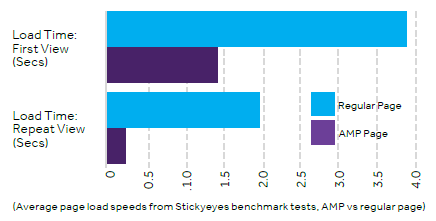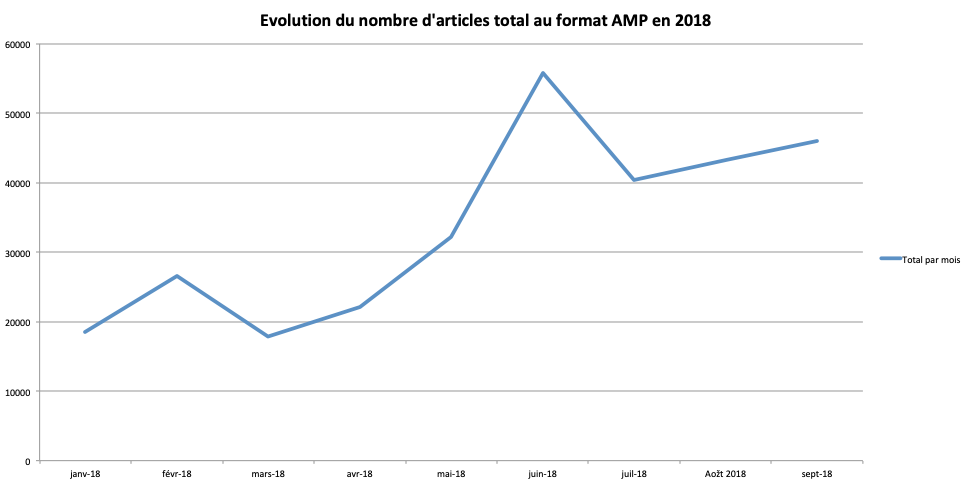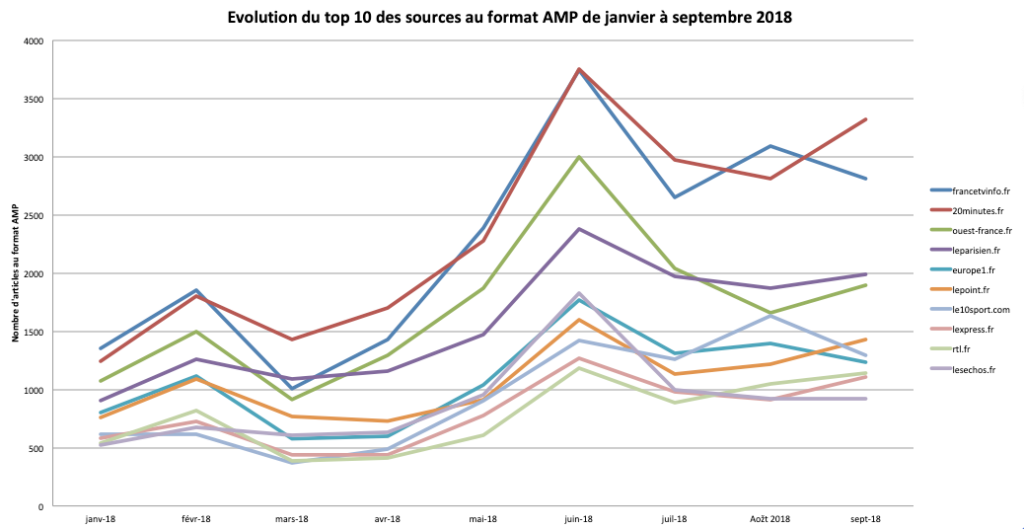AMP or Accelerated Mobile Pages is a specific format and Open Source “light” pages that allows the browser to display the pages of a site much faster. This format is based on a lighter HTML language, significant restrictions on the use of Javascript and CSS as well as caching of AMP pages on Google’s servers.
When we know that in recent years mobile searches have exploded and that after 3 seconds of loading, 40% of Internet users leave the page knowing that this rate increases by 10% per additional second, the AMP format seems to be a godsend to attract more readers (source Studio Web 75).
We often talk about the Google format but this format also exists on other platforms such as Facebook, Instagram or digital kiosks such as Flipboard which also needed to find a solution to the often very long loading time on mobile phones.

But first, where does this format come from?
Launched in 2016 by Google, the first to benefit from it were none other than the media because the search engine offered significant visibility in its Google News carousel, which is now almost reserved for this format (source Keacrea).
At that time, it was the first time that mobile traffic was higher than desktop traffic worldwide.
The two main reasons for this new format creation were that:
- Google was able to fill a gap in the number of telephone operators who did not offer a sufficiently efficient network for loading this very heavy content.
- Press publishers faced great display difficulties due to written content, videos, photos, advertisements, etc.
It should be noted that once this new format was adopted, the question of going there was no longer raised, but rather what were the risks of not being there.
Technically, how does the AMP work?
The AMP is nothing more than an HTML page to which we add images, a rather minimalist CSS code and as little JavaScript as possible. For each feature offered by the page in question (video player for example), we can still load a specific JavaScript and possibly a corresponding piece of CSS code. Despite the evolution of the standard in recent years, the philosophy remains the same: only charge what is necessary, nothing more.
Note that when validating the page’s AMP code, you must be very careful because a single error can cause the page in question to be de-displayed. Since February 2018, it is also mandatory to display the same content on a classic web page and its AMP version, otherwise Google will not take the latter into account.
Google highlights this type of content in its search results, materializing for articles with a small grey “lightning” icon. The loading time would then be ultra fast with a performance of 0.7 sec compared to 22 sec on standard sites (Neoptimal source).

Where does the GPA stand two years later?
In recent months, the AMP format has offered increased visibility in SERPs with the appearance of featured snippets (source Resoneo). Although the press is still the main actor to benefit from it, many sites outside the traditional media tend to use this format. Some had questioned the benefits of AMP (source Siècle Digital) but now many SEO experts are promoting the benefits of this format.
For the press, the increase in the appearance of this format is very clear in 2018. However, there was a decrease during the month of July (note that Google had announced a major update of its algorithm in August).

Source: Ozae data
The question of the usefulness of the AMP is therefore less and less discussed and recently Le Monde and Le Figaro decided to place themselves on it in the same way as 20 Minutes or Ouest-France who have been using it for some time.
The ranking of the 10 most efficient sources to be placed on the format are:
The most widely represented sources are therefore the generalist media. However, Le 10 Sport adopts a pioneering attitude towards its sector since it is the only sports media to be present in the Top 10.

Source: Ozae data
There is clearly a first peak in February and a much larger one in June 2018. 20 Minutes and France TV info regularly fight for first place in this format and in September, 20 Minutes clearly gains momentum compared to other media.
What are the other interests of the AMP and how to place yourself on the right keywords?
The AMP format would also indirectly allow to be better referenced in Google by increasing the loading speed which has an impact on the ranking in the sense that sites that are too slow are penalized. Also, mobile compatibility is a ranking criterion, Google highlights in its carousel the AMP formats (as explained above).
In general, Google continues to push for the AMP or at least the adoption of similar standards with the W3C. Indeed, a standardized web is a simpler web to understand for Google. In addition, a faster web is a cheaper web to crawl for Google.
To place itself on the right keywords, Ozae updates daily a list of keywords on the topics that buzz most on Google News, on the articles appearing in Google News, then these keywords are checked several times a day in Google to see on how many AMP formats the sources emerge, on which keywords, how much visibility they cover etc.
A good way to optimize your placement on this format.
Conclusion :
The AMP format is a format that despite a timid start, has now grown and will play a major role in new traffic sources, especially with Google’s new mobile design with Discover (although this format is not mandatory on this platform) which has just been deployed in the US (source).
Ozae is a monitoring and analysis tool that scans news published on Google News, Apple News FR and Google results (AMP, Onebox News and organic results).
Do you want to optimize your visibility?
Contact us for a personalized demonstration: [email protected]
